Gujarati Lilva kachori Recipe

Gujarati Lilva kachori Recipe 🫓 Gujarati Lilva Kachori Recipe Making (Green Pigeon Pea Stuffed Crispy Kachori – A Winter Specialty of Gujarat) Lilva Kachori is a traditional Gujarati snack made from lilva (fresh green pigeon peas) stuffed into a spiced filling and encased in a crisp, flaky outer crust.It’s especially popular during the winter months when lilva is fresh and abundant.Golden and crispy on the outside, soft and flavorful inside — these kachoris are an irresistible part of Gujarati farsan! 🌿 Ingredients For the Dough: Maida (refined flour) – 2 cups Rava (semolina) – 1 tbsp Salt – ½ tsp Oil – 2 tbsp (for moyan) Water – as needed (to knead a soft, pliable dough) For the Filling: Fresh lilva (green pigeon peas) – 1 cup (coarsely crushed or mashed) Green chillies – 2 (finely chopped or crushed) Ginger paste – 1 tsp Garlic paste – ½ tsp (optional) Coriander leaves – 2 tbsp (chopped) Lemon juice – 1 tbsp Sugar – ½ tsp Salt – to taste Cumin seeds – ½ tsp Asafoetida (hing) – a pinch Turmeric powder – ¼ tsp Oil – 1 tbsp (for sautéing) For Frying: Oil – for deep frying 👩🍳 Preparation 1. Prepare the Dough In a mixing bowl, combine maida, semolina, and salt. Add oil and rub it into the flour with your fingers until crumbly. Gradually add water and knead into a soft, smooth dough (not sticky). Cover with a damp cloth and let it rest for 15–20 minutes. 2. Make the Lilva Filling Heat 1 tbsp oil in a pan. Add cumin seeds and hing. Let them crackle. Add green chillies, ginger, and garlic paste. Sauté for 30 seconds. Add the coarsely crushed lilva. Stir and cook on medium heat for 5–6 minutes until moisture reduces. Add turmeric, salt, sugar, lemon juice, and chopped coriander. Mix well. Cook for another 2–3 minutes till the mixture is dry. Let the mixture cool completely. 3. Shape the Kachoris Divide the dough into small lemon-sized balls. Flatten one ball slightly and make a small cup shape. Place 1 tsp of lilva filling in the center. Gather the edges, seal tightly, and flatten gently between your palms. Make sure the filling doesn’t break through the dough. 4. Fry the Kachoris Heat oil in a deep pan on medium flame. To test, drop a small dough piece — it should rise slowly, not immediately. Fry the kachoris on low to medium heat until golden brown and crisp from all sides. Remove and drain on absorbent paper. 5. Serve Serve hot Lilva Kachoris with green chutney, tamarind chutney, or even a cup of hot masala chai! 💡 Pro Tips ✅ Coarsely grind the lilva — don’t make it into a paste.✅ Always fry on low flame for even cooking and perfect crispness.✅ Add a pinch of sugar and lemon juice for that authentic sweet-tangy Gujarati balance.✅ Can also be baked at 180°C for 20–25 minutes for a healthier version. 🍽️ Serving Suggestion Serve as a farsan item in a Gujarati thali. Enjoy as a winter evening snack with tea. It pairs beautifully with garam masala chai or imli chutney.
Gujarati Chicken Kabab Recipe
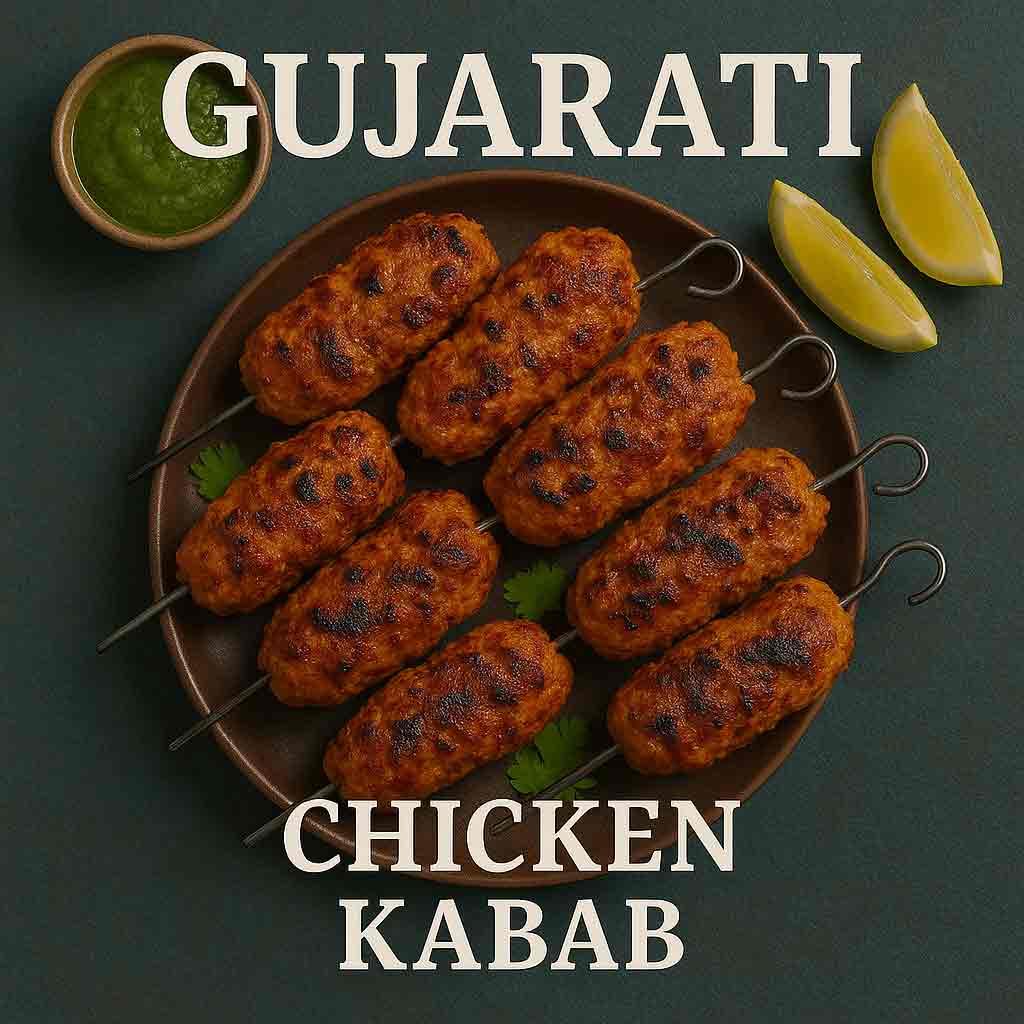
Gujarati Patra Recipe
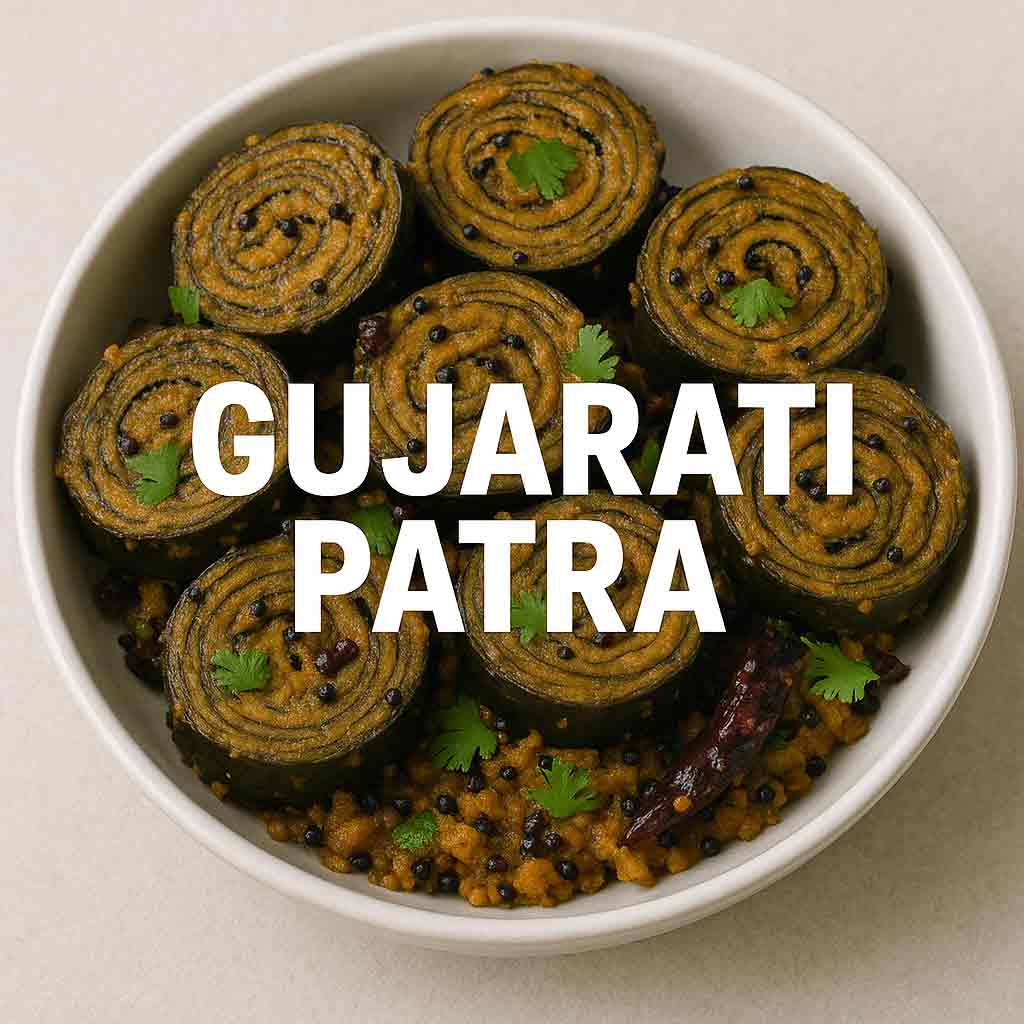
Gujarati Patra Recipe 🌿 Gujarati Patra Recipe Making (Steamed and Fried Colocasia Leaf Rolls with Sweet-Spicy Besan Masala) Patra (Gujarati: Patra na vada or Patrel) is one of Gujarat’s most famous farsan (snack) dishes. It’s made using arbi (colocasia) leaves coated with a spiced gram flour (besan) paste, rolled, steamed, and then sliced and shallow-fried.The combination of sweet, tangy, and spicy flavours makes it an irresistible part of the Gujarati thali or tea-time snack platter. 🪴 Ingredients For the Masala Paste: Gram flour (besan) – 1 cup Tamarind pulp – 2 tbsp Jaggery (grated) – 1 tbsp Green chilli paste – 1 tsp Ginger paste – 1 tsp Red chilli powder – ½ tsp Turmeric powder – ¼ tsp Asafoetida (hing) – a pinch Salt – to taste Water – as needed (to make a thick paste) For the Leaves: Large colocasia leaves (arbi / taro leaves) – 8 to 10 (washed and stalks removed) For Tempering: Mustard seeds – 1 tsp Sesame seeds – 1 tbsp Curry leaves – few Oil – 2 tbsp For Garnish: Grated coconut – 2 tbsp Fresh coriander leaves – 2 tbsp (chopped) 👩🍳 Preparation 1. Prepare the Leaves Choose medium to large colocasia (arbi) leaves — tender, not fibrous. Wash them well and pat dry. Place the leaves with the smooth side facing down. Trim thick veins slightly with a knife or rolling pin to flatten. 2. Make the Besan Masala Paste In a bowl, combine gram flour, tamarind pulp, jaggery, green chilli and ginger paste, red chilli powder, turmeric, asafoetida, and salt. Add a little water gradually to form a thick, smooth, spreadable paste (not runny). Taste and adjust — the masala should be spicy, tangy, and slightly sweet, the signature Gujarati balance! 3. Layer and Roll Place one leaf on a clean surface (veins facing upward). Spread a thin, even layer of the masala paste over it. Place another leaf on top and repeat the process (3–4 leaves per roll). Fold the sides inward and roll tightly from the base upwards. Secure with thread if needed. 4. Steam the Rolls Place the rolls in a steamer and cook for 20–25 minutes, until firm and set. Remove and cool completely before slicing (cooling helps in clean cuts). 5. Slice and Temper Slice the steamed rolls into ½-inch thick rounds. Heat oil in a pan, add mustard seeds, sesame seeds, and curry leaves. Once they splutter, add the patra slices and shallow fry till golden and slightly crispy on both sides. 6. Garnish and Serve Sprinkle grated coconut and chopped coriander over the fried patra. Serve hot or at room temperature. 🍽️ Serving Suggestions Serve Gujarati Patra as: A tea-time snack with green chutney. A side dish in a Gujarati thali. A tiffin snack — it tastes great even when cold! 💡 Pro Tips ✅ Use fresh, tender arbi leaves — older ones may cause itchiness.✅ Always balance tamarind and jaggery — that’s the key to authentic Gujarati taste.✅ Fry on medium heat to keep the outer layer crisp and inner part soft.✅ Store leftovers in the fridge — reheat on a pan to bring back the crispness. 🌶️ Flavor Note Gujarati Patra perfectly captures the Gujarati trifecta of sweet, spicy, and sour. The soft steamed layers and crunchy sesame topping make every bite a burst of texture and taste — a true culinary masterpiece from Gujarat’s farsan tradition.
Bengali Oondhiya Recipe
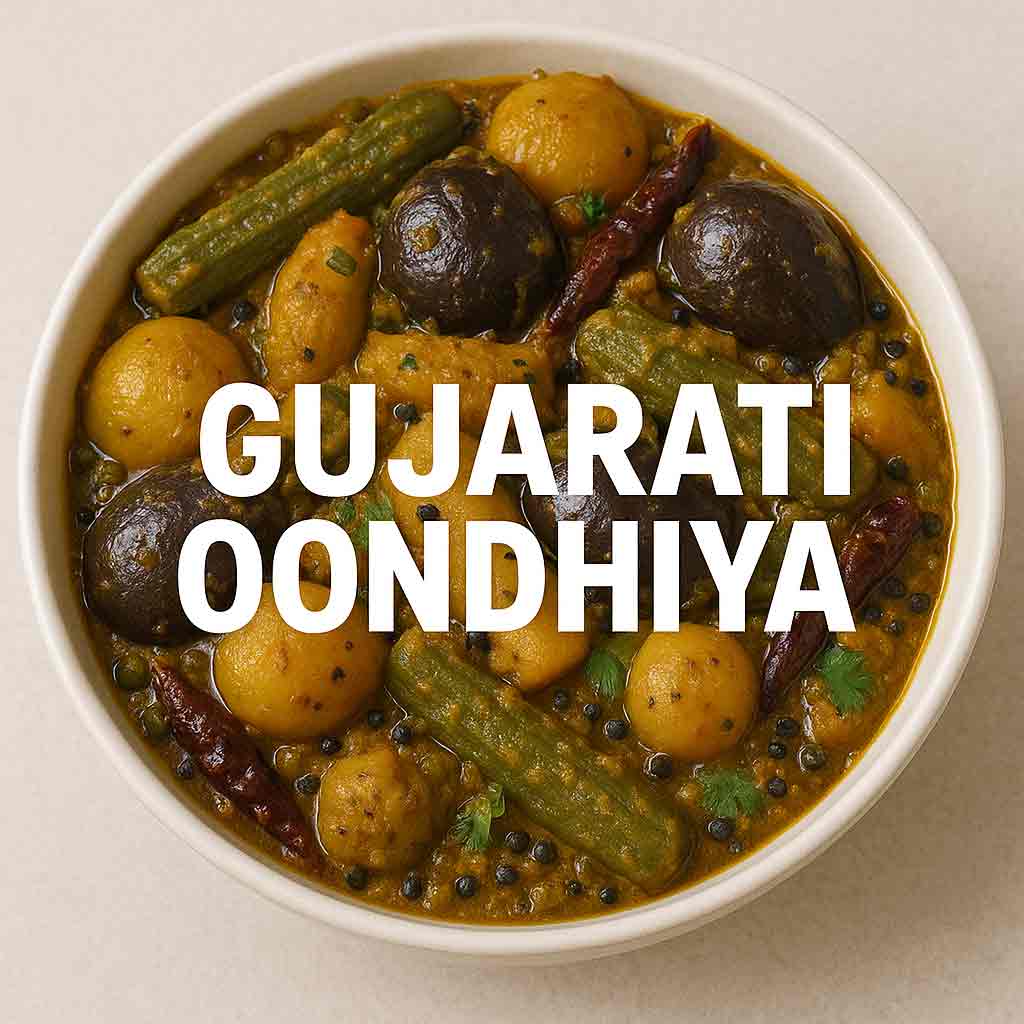
Bengali Oondhiya Recipe 🥘 Bengali Oondhiya Recipe Making (A Bengali twist on the classic Gujarati Undhiyu – hearty, rustic, and flavorful!) This Bengali Oondhiya combines the soul of Gujarat’s vegetable medley with the heart of Bengal’s spice artistry. Seasonal vegetables are slow-cooked in mustard oil, panch phoron, and a touch of coconut and mustard paste, giving the dish a unique East-meets-West Indian flavor. 🌿 Ingredients Vegetables (cut into medium chunks): Brinjal (eggplant) – 1 small Potatoes – 2 small Sweet potato – 1 small Green peas – ½ cup Pumpkin – ½ cup Carrot – 1 medium Raw banana – 1 Beans – 8–10 For the Masala Paste: Mustard seeds – 2 tbsp Poppy seeds – 1 tsp Grated coconut – 2 tbsp Green chillies – 2 Ginger – 1 inch Garlic – 3 cloves (optional) Turmeric powder – ½ tsp Water – as needed Other Ingredients: Mustard oil – 3 tbsp Panch phoron (Bengali five-spice mix) – 1 tsp Bay leaf – 1 Tomato – 1 (chopped) Salt – to taste Sugar – ½ tsp Water – as needed Fresh coriander leaves – for garnish 👩🍳 Preparation 1. Prepare the Masala Paste Soak mustard and poppy seeds in warm water for 15–20 minutes. Grind with green chillies, coconut, ginger, garlic, and turmeric into a smooth paste. 2. Fry the Vegetables Heat mustard oil in a large kadhai till it smokes lightly. Add potatoes, brinjal, pumpkin, and sweet potato; fry lightly until golden. Remove and set aside. 3. Temper and Sauté In the same oil, add panch phoron and bay leaf. When they crackle, add the ground masala paste. Fry on medium flame till oil separates and raw aroma fades. 4. Combine and Cook Add chopped tomatoes, salt, and sugar. Stir well. Add all the fried vegetables and green peas. Mix to coat evenly with masala. Add about ½ cup of water, cover, and cook on low flame for 15–20 minutes, stirring occasionally, until vegetables are soft and flavours have melded. 5. Finish and Serve Drizzle a teaspoon of mustard oil or ghee before serving for extra aroma. Garnish with fresh coriander leaves. 🍛 Serving Suggestion Serve Bengali Oondhiya hot with steamed rice, luchi, or paratha.It makes a wholesome vegetarian main course that celebrates the best of both Bengali and Gujarati kitchens. 💡 Pro Tips ✅ Use seasonal winter vegetables for authentic Undhiyu-like variety.✅ Adjust the mustard paste’s intensity — more for pungency, less for mildness.✅ Slow cooking helps the vegetables absorb the masala perfectly.
Bengali Mocha Ghanto Recipe
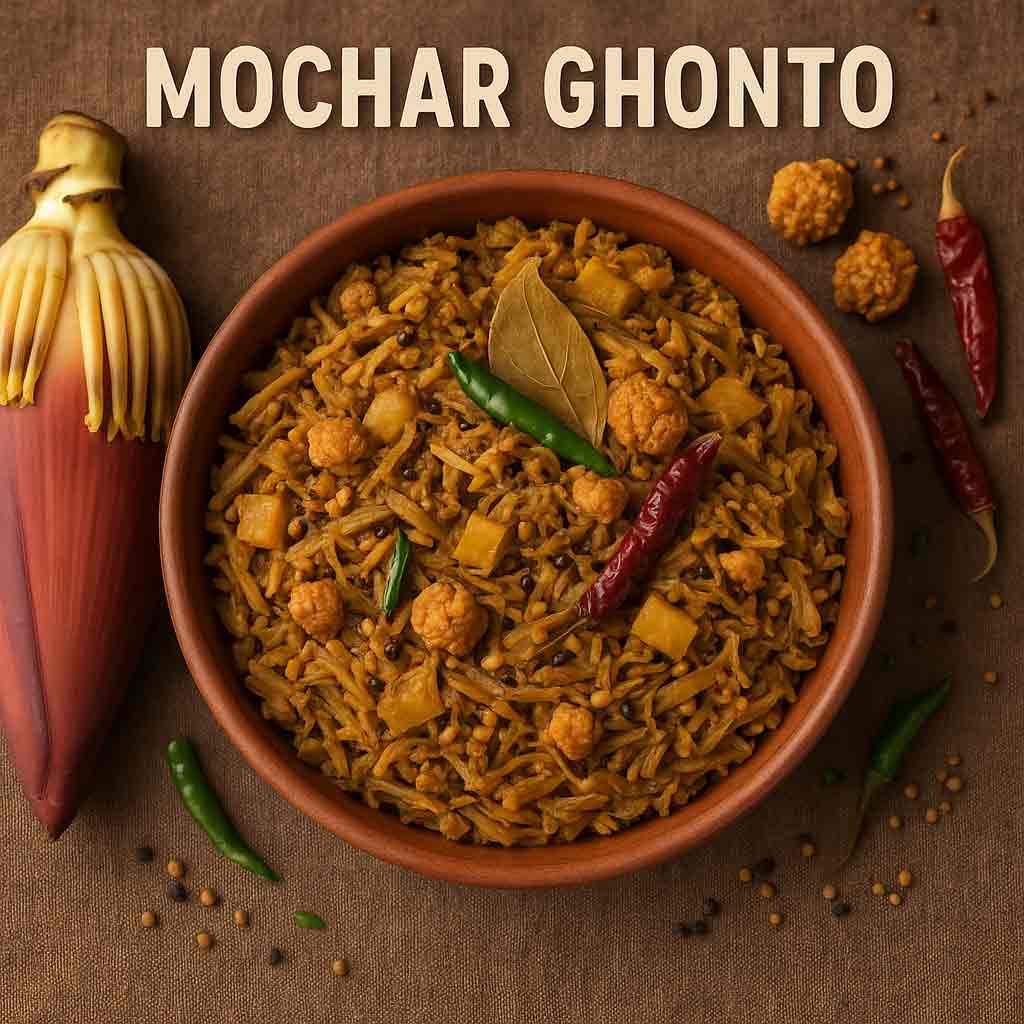
Bengali Mocha Ghanto Recipe 🌿 Bengali Mocha Ghonto Recipe Making (Banana Flower Curry – a classic Bengali delicacy) Mocha Ghonto is a traditional Bengali dish made from banana flower (mocha), cooked slowly with grated coconut, potatoes, and aromatic spices. It’s a labor of love — peeling and cleaning the banana flower takes time, but the end result is a flavorful, nutty, and comforting curry that’s both nutritious and nostalgic. 🌸 What is Mocha? In Bengali, mocha refers to the banana blossom or banana flower. It’s rich in fiber and iron and forms an integral part of Bengali vegetarian cuisine, especially in traditional households and festive spreads. 🥣 Ingredients Main Ingredients: Banana flower (mocha) – 1 medium (cleaned and finely chopped) Potato – 1 large (cubed) Grated coconut – 2 tbsp Bay leaf – 1 Cumin seeds – ½ tsp Dry red chilli – 1 Ginger paste – 1 tsp Cumin powder – ½ tsp Coriander powder – ½ tsp Turmeric powder – ½ tsp Red chilli powder – ½ tsp Garam masala – ¼ tsp Sugar – ½ tsp Salt – to taste Mustard oil – 2 tbsp Ghee – 1 tsp (for finishing) Optional (Traditional Add-ins): Kala chana (black chickpeas, soaked & boiled) – 2 tbsp Grated coconut or fried coconut bits – for garnish Green chillies – 2 (slit) 👩🍳 Preparation 1. Clean and Boil the Banana Flower Remove the outer purple leaves and separate the florets. Clean each floret by discarding the hard stigma and plastic-like calyx. Chop finely and soak in turmeric water with a pinch of salt for 10–15 minutes. Boil in water until soft, then drain and squeeze out excess water. Set aside. 2. Fry the Potatoes Heat mustard oil in a pan until smoking point, then reduce the flame. Fry the potato cubes till golden and set aside. 3. Prepare the Mocha Ghonto In the same oil, add bay leaf, cumin seeds, and dry red chilli. Once they splutter, add ginger paste and sauté till fragrant. Add cumin powder, coriander powder, turmeric, and red chilli powder. Sauté for a minute. Add the boiled mocha (banana flower) and mix well. Add salt, sugar, and a splash of water. Cover and cook on low flame for 10–12 minutes, stirring occasionally. 4. Add Finishing Touches Add the fried potatoes and grated coconut (and boiled kala chana if using). Cook uncovered until everything blends together and moisture evaporates. Add garam masala and ghee; mix well. Garnish with fresh grated coconut or green chillies. 🍛 Serving Suggestion Serve Mocha Ghonto hot with steamed rice or luchi.Traditionally, it’s part of a niramish (pure vegetarian, without onion or garlic) Bengali meal served on special occasions. 💡 Pro Tips ✅ Cleaning mocha properly prevents bitterness.✅ Always cook it slowly to develop the rich, earthy flavor.✅ For a festive touch, top with a drizzle of ghee and fried coconut bits.
Bengali Dal recipe
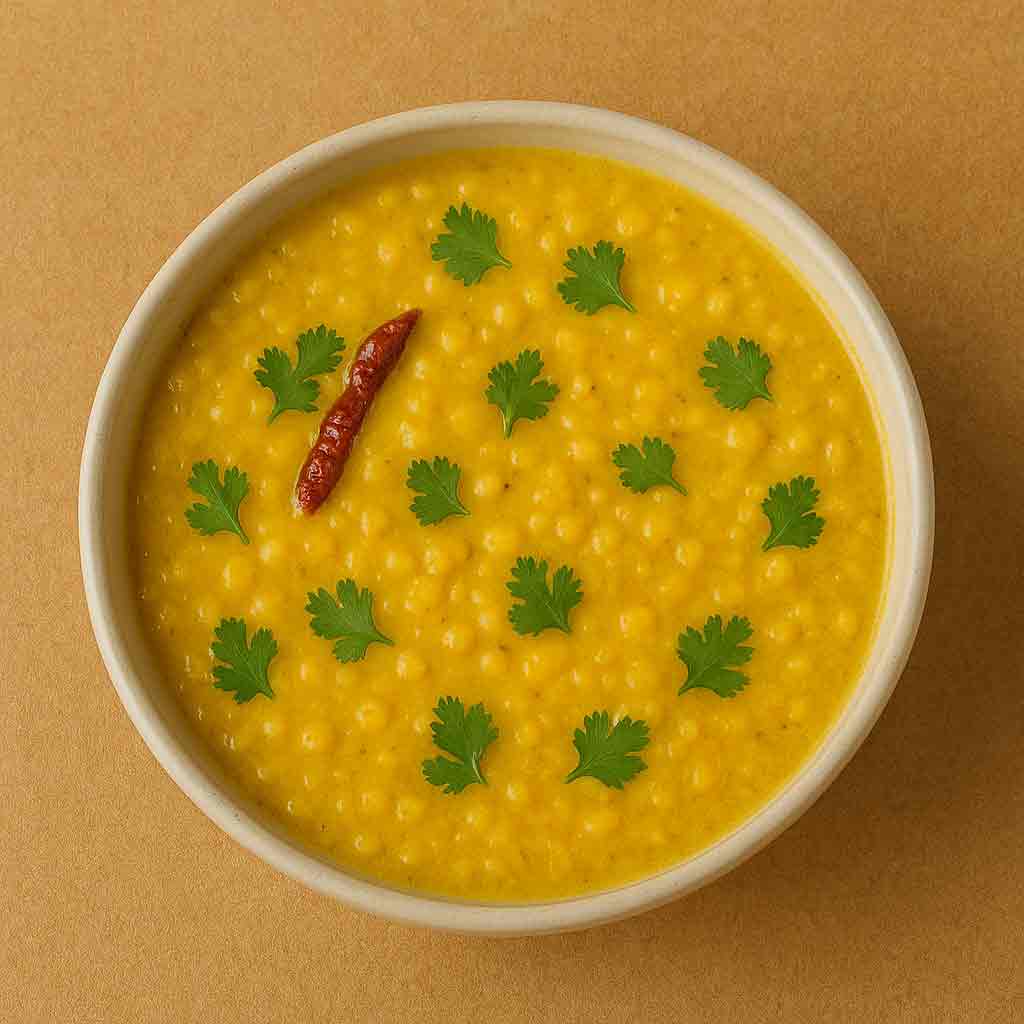
Bengali Dal recipe 🟡 1. Bengali Cholar Dal (Festive Bengal Gram Dal) 🌿 Ingredients Chana dal (Bengal gram) – 1 cup Bay leaf – 1 Dry red chillies – 2 Cinnamon stick – 1 inch Cardamom – 2 Cloves – 2 Ginger paste – 1 tsp Grated coconut – 2 tbsp (optional, lightly fried) Turmeric powder – ½ tsp Sugar – ½ tsp Salt – to taste Ghee – 2 tbsp Mustard oil – 1 tsp (optional, for aroma) 👩🍳 Method Boil the Dal Wash and soak the chana dal for 30 minutes. Pressure cook with turmeric and enough water till soft but not mushy (about 3–4 whistles). Prepare the Tempering Heat ghee in a pan. Add bay leaf, red chillies, cinnamon, cardamom, and cloves. Add ginger paste and fry for a few seconds. Combine and Simmer Add boiled dal to the pan. Mix well, add salt, sugar, and fried coconut (if using). Simmer on low flame for 5–7 minutes till it thickens slightly. Finish and Serve Add a drizzle of ghee or mustard oil on top before serving. 🍛 Serve with: Hot Luchi, Koraishutir Kachori, or Steamed Rice. 🟠 2. Bengali Moong Dal (Bhaja Muger Dal – Everyday Comfort Dal) 🌿 Ingredients Moong dal – 1 cup Bay leaf – 1 Dry red chillies – 2 Green chillies – 2 (slit) Ginger paste – 1 tsp Turmeric powder – ½ tsp Mustard oil – 1 tbsp Ghee – 1 tbsp Salt – to taste Sugar – ½ tsp 👩🍳 Method Dry Roast the Dal In a dry pan, roast moong dal on low flame until lightly golden and fragrant. Wash it gently afterward (optional). Boil the Dal Pressure cook with turmeric and water (2½ cups) till soft but not mushy. Prepare the Tempering Heat mustard oil in a pan. Add bay leaf and red chillies; let them splutter. Add ginger paste and green chillies; sauté briefly. Add and Simmer Pour in the boiled dal, add salt and sugar, and simmer for 5 minutes. Add ghee at the end for that authentic Bengali aroma. 💡 Pro Tips ✅ Don’t overcook the dal — Bengali dals should retain texture.✅ Always finish with ghee or a touch of mustard oil for aroma.✅ For festive flavour, garnish with fried coconut pieces or cashews. 🍽️ Serving Suggestion Cholar Dal → Best with Luchi or Kachori Bhaja Moong Dal → Perfect with Steamed Rice, Aloo Bhaja, or Begun Bhaja (fried brinjal slices)
Bengali Luchi Recipe
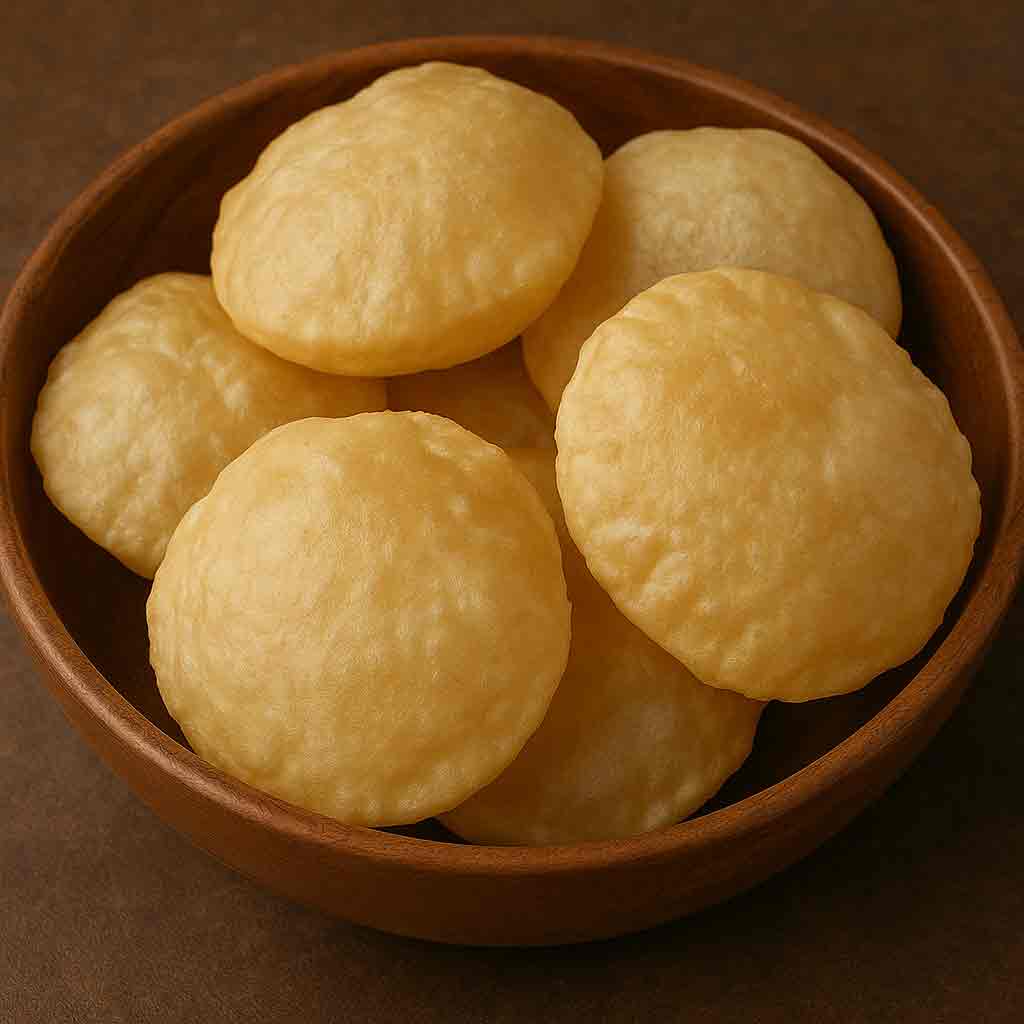
Bengali Luchi Recipe Bengali Luchi Recipe Making (Soft, Puffy, and Golden – The Heart of a Bengali Breakfast) Luchi is a classic Bengali delicacy — soft, puffed, deep-fried flatbreads made from refined flour. Unlike the North Indian puri, which uses whole wheat flour, luchi is made with maida (all-purpose flour), giving it a light, melt-in-the-mouth texture. It’s typically served with Cholar Dal, Aloor Dum, or even a simple sprinkle of sugar for children. 🌿 Ingredients Maida (all-purpose flour) – 2 cups Salt – ½ tsp Ghee or oil – 1 tbsp (for kneading) Water – as needed (lukewarm) Oil – for deep frying Preparation Make the Dough In a mixing bowl, combine maida and salt. Add ghee (or oil) and mix using your fingertips until the flour turns crumbly. Gradually add water and knead into a smooth, firm dough — not too soft. Cover with a damp cloth and rest for 15–20 minutes. Divide and Roll Divide the dough into small lemon-sized balls. Roll each ball into a smooth round disc (about 4–5 inches diameter). Dust lightly with flour if needed, but avoid excess — luchis should remain white and smooth. 🔥 Frying the Luchis Heat the Oil Heat oil in a deep pan or kadhai on medium-high flame. To test, drop a small piece of dough — if it rises immediately, the oil is ready. Fry the Luchi Gently slide one rolled luchi into the hot oil. Lightly press with a slotted spoon — it will puff up beautifully! Flip and fry both sides until lightly golden (not brown). Remove and drain on paper towels. Repeat Fry the remaining luchis one at a time, maintaining oil temperature. 🍛 Serving Suggestion Serve hot, puffy Luchis with: Cholar Dal (sweet Bengal gram dal) Aloor Dum (spicy potato curry) Sujir Halwa (semolina pudding)or even a dollop of ghee and sugar for a nostalgic Bengali treat.
Bengali Fish In Mustard Oil Curry Recipe
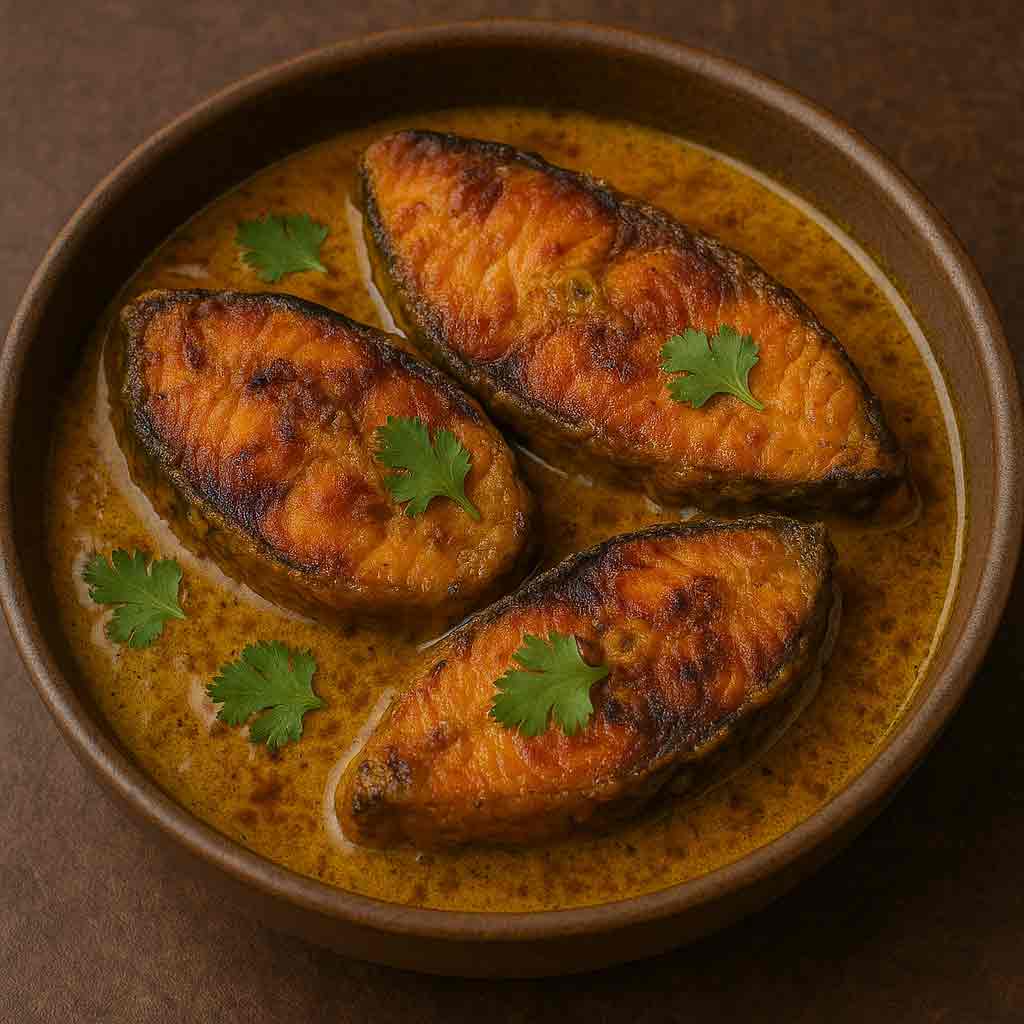
Bengali Fish In Mustard Oil Curry Recipe 🐟 Bengali Fish in Mustard Oil Curry Recipe Making (Shorshe Maach – Fish in Mustard Gravy) A true symbol of Bengali cuisine, Shorshe Maach is a tangy, pungent, and deeply aromatic dish made with fresh fish simmered in a mustard-based sauce. Cooked in mustard oil, it’s simple, soulful, and full of character — a must-try for every seafood lover. 🌿 Ingredients For the Mustard Paste: Yellow mustard seeds – 2 tbsp Green chillies – 2 Poppy seeds (optional) – 1 tsp Turmeric powder – ¼ tsp Salt – a pinch Water – as needed For the Curry: Rohu / Hilsa / Katla fish – 500 g (cut into medium pieces) Mustard oil – 4 tbsp Kalonji (nigella seeds) – ½ tsp Green chillies – 2 (slit) Turmeric powder – ½ tsp Red chilli powder – ½ tsp Salt – to taste Water – 1 cup 🐠 Method Marinate the Fish Wash and pat dry the fish pieces. Rub with turmeric and salt. Set aside for 15 minutes. Prepare the Mustard Paste Soak mustard seeds and poppy seeds in warm water for 15–20 minutes. Grind them with green chillies, salt, and turmeric to a smooth paste using a little water. (Tip: Blend gently — over-grinding can make mustard bitter.) 🔥 Cooking the Curry Fry the Fish Heat mustard oil till it smokes slightly, then reduce flame. Lightly fry the fish pieces on both sides until golden. Remove and keep aside. Temper the Oil In the same pan, add nigella seeds and slit green chillies. Let them splutter and release aroma. Add the Mustard Paste Lower the heat and add the prepared mustard paste. Stir continuously and cook for 2–3 minutes until raw smell disappears. Add Water & Simmer Add 1 cup of warm water to adjust the curry consistency. Bring it to a gentle boil. Add the Fried Fish Gently slide in the fried fish pieces. Simmer for 5–7 minutes on low flame, allowing flavours to infuse. Finish & Serve Once oil floats on top and gravy thickens slightly, turn off the heat. Rest for a few minutes before serving. 🍚 Serving Suggestion Serve Shorshe Maach hot with steamed rice and a wedge of lemon.The bold mustard flavour pairs beautifully with the softness of fish and plain rice.
Bengali Malai Prawn Curry Recipe
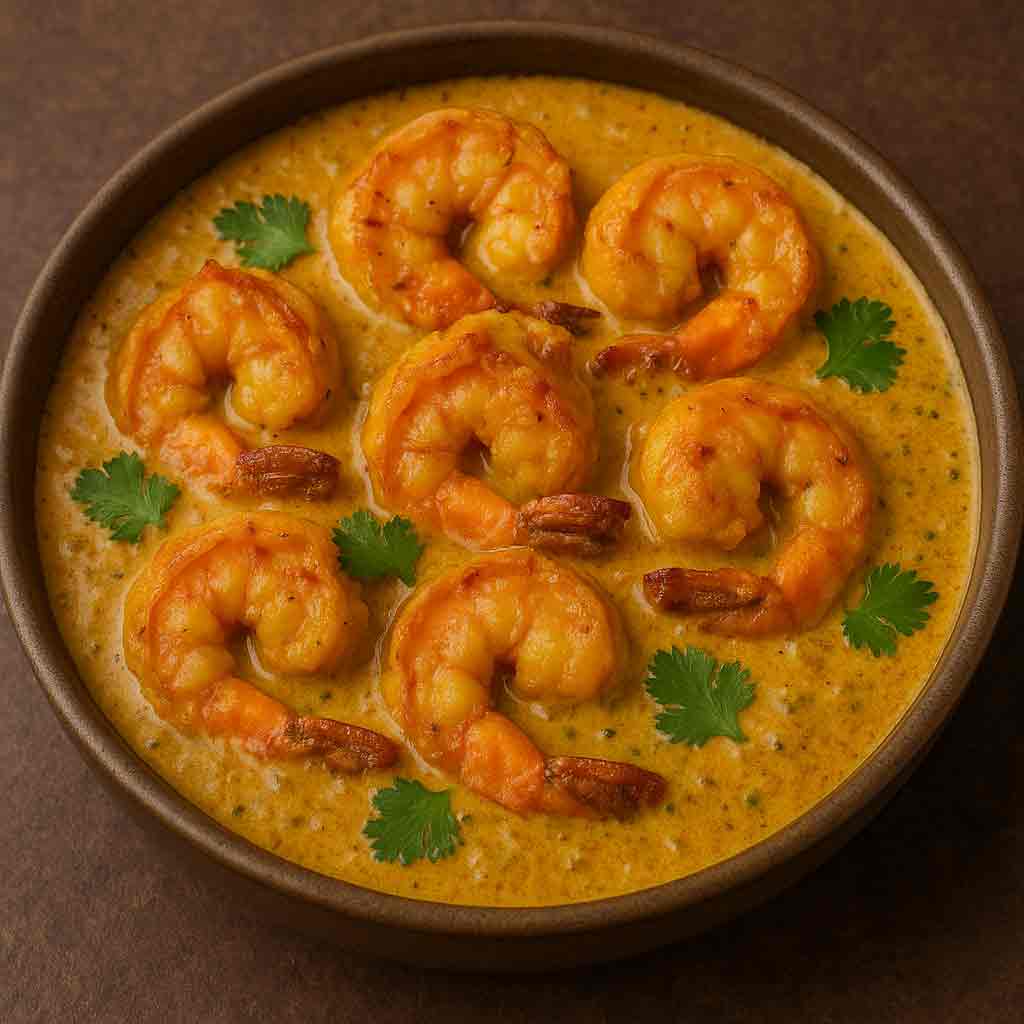
Bengali Malai Prawn Curry Recipe 🍤 Bengali Malai Prawn Curry Recipe Making (Chingri Malai Curry – Creamy, Rich & Royal Bengali Delight) A crown jewel of Bengali cuisine, Chingri Malai Curry (Prawn Coconut Curry) combines the delicate sweetness of prawns with the richness of coconut milk and subtle Bengali spices. Traditionally served on festive occasions, this dish is both comforting and luxurious. 🌿 Ingredients For the Curry: Large prawns (cleaned and deveined) – 500 g Coconut milk – 1½ cups (thick) Onion – 2 medium (finely sliced) Ginger paste – 1 tsp Garlic paste – 1 tsp Green chillies – 2–3 (slit) Turmeric powder – ½ tsp Red chilli powder – ½ tsp Bay leaf – 1 Cinnamon – 1-inch stick Cardamom – 2 Cloves – 2 Sugar – ½ tsp (optional) Salt – to taste Mustard oil – 2 tbsp (or vegetable oil if preferred) 🦐 Preparation Clean and Marinate the Prawns Wash prawns and pat dry. Marinate with salt and a pinch of turmeric. Set aside for 15–20 minutes. Lightly Fry the Prawns Heat mustard oil until it smokes slightly. Lightly fry prawns for 30–40 seconds per side (do not overcook). Remove and keep aside. 🔥 Making the Malai Curry Prepare the Spice Base In the same pan, add bay leaf, cinnamon, cardamom, and cloves. Add sliced onions and sauté until golden brown. Add ginger and garlic pastes, then sauté for 2–3 minutes. Add the Masalas Stir in turmeric and red chilli powder. Add a few tablespoons of water to prevent burning. Mix well until the oil begins to separate. Pour in Coconut Milk Add thick coconut milk slowly, stirring to blend with the spices. Add green chillies, sugar (if using), and salt. Simmer on low flame for 5–7 minutes — do not boil vigorously or the coconut milk may curdle. Add the Fried Prawns Gently slide the prawns into the simmering gravy. Cook on low heat for 5 minutes, allowing the prawns to soak up the flavours. Finish the Curry Turn off the flame once oil starts floating on top and the gravy thickens. Cover and let it rest for a few minutes. 🍚 Serving Suggestion Serve Chingri Malai Curry hot with steamed basmati rice or ghee rice.The mild sweetness of coconut milk perfectly balances the subtle heat and aroma of mustard oil.
Andhra Mutton Briyani Recipe
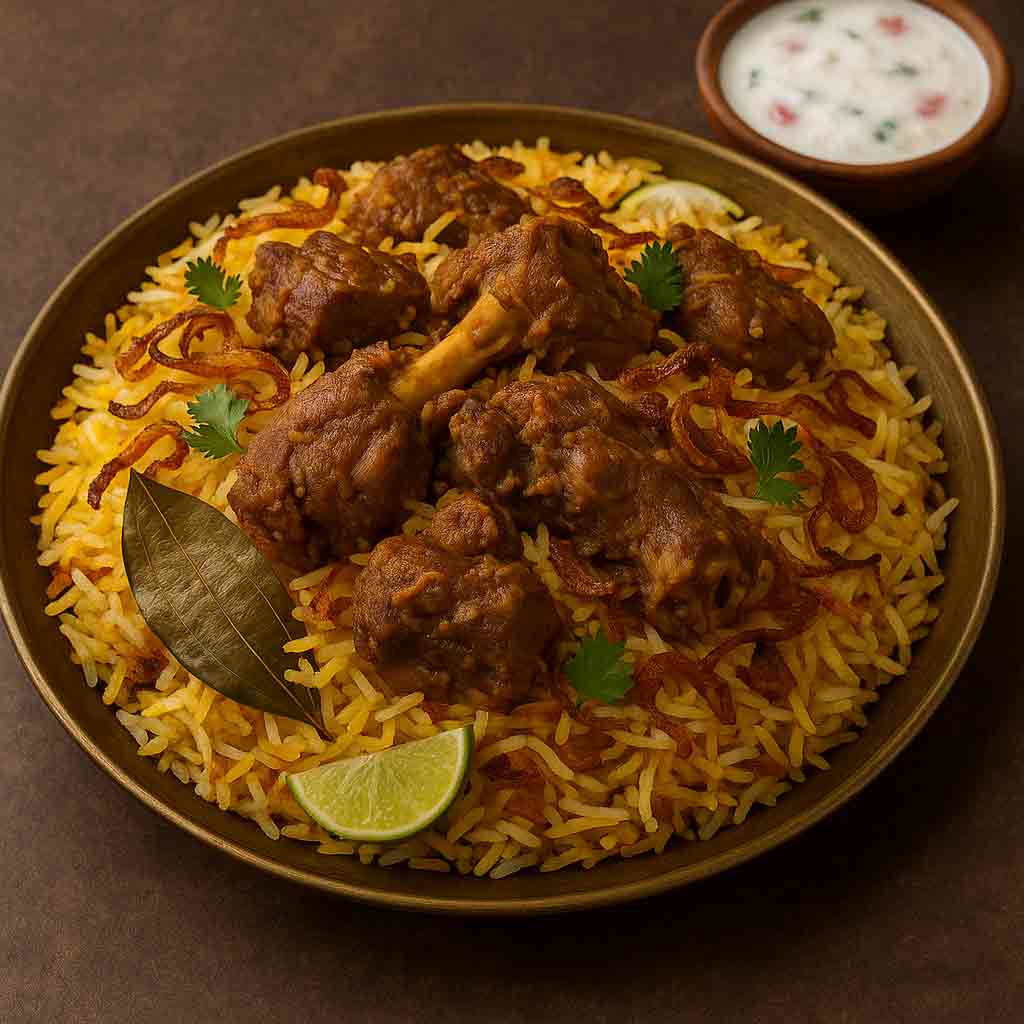
Andhra Mutton Briyani Recipe 🍗 Andhra Mutton Biryani Recipe Making (Spicy, flavorful, and irresistibly aromatic — a Andhra classic!) This biryani brings together tender mutton, basmati rice, and bold Andhra spices — cooked in the traditional dum style for that perfect blend of heat and aroma. It’s a dish made for celebrations and hearty family meals alike. 🌿 Ingredients For Marination: Mutton (bone-in pieces) – 750 g Yogurt – ½ cup Ginger-garlic paste – 2 tbsp Green chillies – 3 (slit) Red chilli powder – 1½ tsp Coriander powder – 1 tsp Garam masala – ½ tsp Turmeric powder – ¼ tsp Fried onions – 2 tbsp Lemon juice – 1 tbsp Fresh mint leaves – 2 tbsp (chopped) Fresh coriander leaves – 2 tbsp (chopped) Salt – to taste For Rice: Basmati rice – 2 cups (soaked 30 mins) Whole spices – bay leaf (1), cinnamon (1″), cloves (3), cardamom (3), star anise (1) Salt – to taste For Cooking: Ghee – 2 tbsp Oil – 2 tbsp Fried onions, mint, and coriander – for garnish 🔥 Method Marinate the Mutton Mix mutton with all marinade ingredients. Cover and refrigerate for at least 3–4 hours, preferably overnight for best results. Cook the Mutton Heat oil and ghee in a heavy-bottomed pan or pressure cooker. Add marinated mutton and cook until it browns slightly. Add ½ cup water, cover, and pressure cook for 3–4 whistles until mutton turns tender. Once done, reduce the gravy till thick (no excess liquid). Cook the Rice In another pot, boil water with whole spices and salt. Add soaked rice and cook till 70% done (the grains should still be firm). Drain and keep aside. Layer the Biryani In a heavy-bottomed pot (or handi), add a layer of cooked mutton. Spread half the rice over it. Add a few fried onions, mint, and coriander. Repeat the layers, finishing with rice on top. Sprinkle 2 tbsp ghee, saffron milk (optional), and fried onions on top. Dum Cooking (Steam Seal Method) Seal the pot with dough or a tight lid. Cook on low flame for 20–25 minutes (or bake covered in oven at 160°C for 25 minutes). Allow it to rest for 10 minutes before opening. Serve Gently fluff the biryani from the sides to mix layers without breaking rice grains. Serve hot with raita, mirch ka salan, or boiled eggs. 🍽️ Pro Tips ✅ Use seeraga samba rice for a more traditional South Indian touch.✅ Adjust chilli and garam masala for the signature Andhra spice kick.✅ Letting the biryani rest after cooking enhances the aroma and flavour.
